Concurrent Employment Action (PY)
Use this procedure to complete the payroll portion of the Concurrent Employment Action. The Personnel Administration portion of the Concurrent Employment Action must be completed first.
As the payroll processor, you will not process this action until you have received the concurrent employment action information packet from the personnel administration processor indicating they have completed their portion of the action.
This procedure may require hand-offs to other roles (such as benefits and time and attendance processors) depending on the details of the concurrent employment appointment, the structure of your agency, and your role at the agency. However, benefits are not maintained in this action. If the employee is eligible for benefits, they must be maintained manually (contact your agency's benefits processor).
A concurrent employment action is used when an employee will have multiple positions in the same agency and will be paid hourly in one position and monthly in one, or when an employee will be employed by more than one agency.
When an employee has multiple personnel numbers due to concurrent employment, you must coordinate between agencies and/or within your agency on several topics such as benefits, hours worked, leave eligibility, and leave accruals. Employees are not allowed to accrue more than eight hours of sick leave in a month across all personnel numbers; manual adjustments may be needed.
Several infotypes are shared between personnel numbers. These infotypes can be updated by both agencies. Shared infotypes are not maintained in this action. The following infotypes are shared:
- Personal Data (0002)
- Addresses (0006)
- Reference Personnel Number (0031)
- Bank Details (0009)
- Family Member Dependents (0021)
- Education (0022)
- Additional Personal Data (0077)
- Military Service (0081)
- Residence Status (0094)
- Time Specification/Employ. Period (0552)
Tax adjustments are necessary for employees who are concurrently employed and will exceed the OASI maximum for the year. Payroll processors should refer to the Payroll Results Adjustment procedures for more information.
The employee will receive separate payments and W2s for each personnel number.
-
Step 1
Enter transaction code PA40 in the command field and click the Enter button.
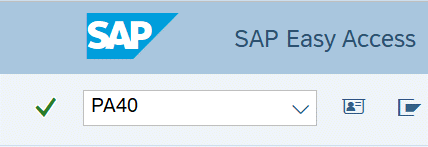
-
Step 2
Complete the following field:
- Personnel no.
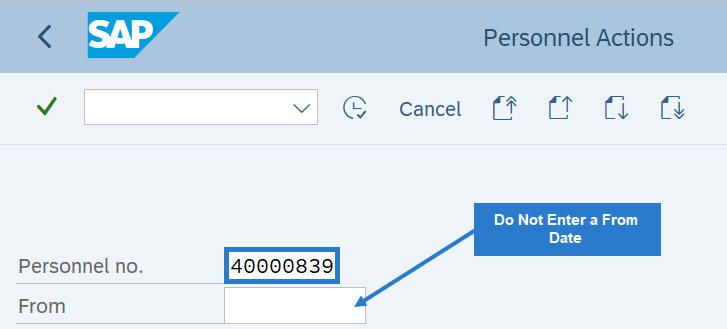 TIPS:
TIPS:Do not enter a From date in the field prior to executing the transaction.
-
Step 3
Click Enter to populate the employee information.
-
Step 4
Select the Concurrent Employment radio button.
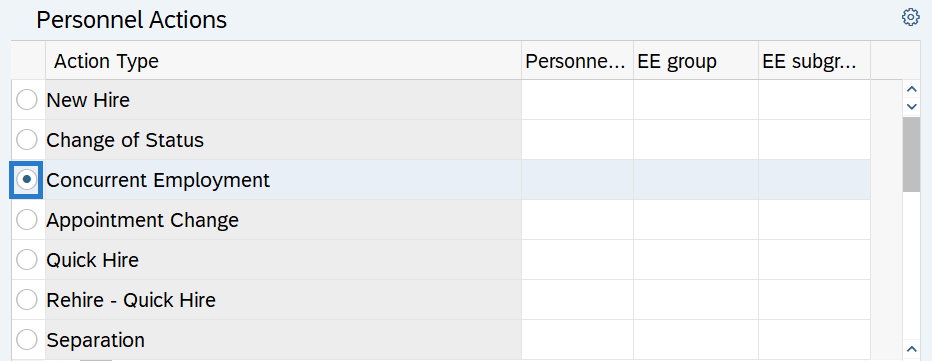
-
Step 5
Click the Execute button to begin the transaction.

-
Step 6
Verify the information is correct in the Change Actions (0000) infotype.
-
Step 7
Click the Execute info group button.

-
Step 8
Click Continue in the Execute info group dialog box.
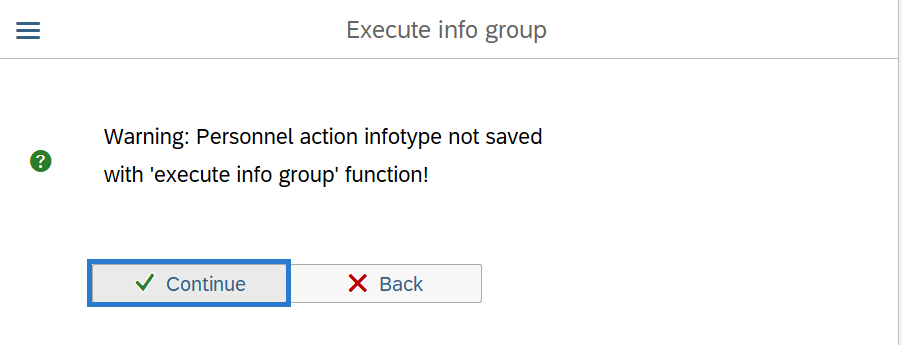
-
Step 9
If you have a recurring payment or deduction to enter for the employee, click the Next Record button until you reach the Create Recurring Payments/Deduction (0014) infotype and procede to Step 10.
If you do not have a recurring payment or deduction to enter, click the Next Record button until you reach the Unemployment State (0209) infotype and skip to Step 13.
-
Step 10
Complete the Recurring Payments/Deductions (0014) infotype.
The following fields are mandatory:
- Wage Type
- Amount
The following field is conditional:
- Payment Model
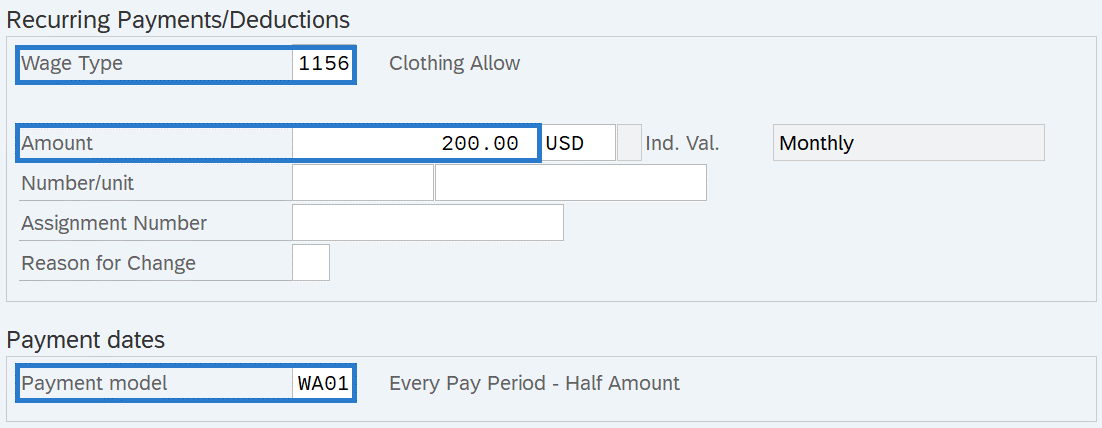 TIPS:
TIPS:If the Payment Model is left blank, the system will default to WA04 - Every Pay Period - Full Amount.
Choose from one of the following Payment Model codes:
- WA01: Every Pay Period - Half Amount
- WA02: 25th Pay Period - Full Amount
- WA03: 10th Pay Period - Full Amount
- WA04: Every Pay Period - Full Amount
- 1162: April 10th and October 10th
- 1163: Jan 25th - Annually
Do not use Payment Model codes other than those listed above.
If the Wage Type selected requires an amount and you have not created an entry in the Amount field, you will receive the following error:

Enter Amount and click Enter to correct.
If the Wage Type selected has a standard Amount/Rate/Max and cannot be changed, you will receive the following error:

Remove Amount and click Enter to correct.
During the Concurrent Employment Action, only one Recurring Payment/Deductions (0014) infotype record can be created. If the employee has multiple Recurring Payments/Deductions, follow the Recurring Payment/Deduction - Create New Record procedure.
-
Step 11
Click the Enter button to validate the information.
-
Step 12
Click the Save button.
-
Step 13
Complete the Unemployment State (0209) infotype.
The following fields are mandatory:
 TIPS:
TIPS:Set the Tax authority to the state in which your employee is covered (where the work is localized); only Washington, Oregon, and Idaho are configured in HRMS. If the employee’s work is localized in Oregon or Idaho, you may also update the Unemployment State during the Additional Steps for Out-of-State Employees process.
For employees with Washington (WA) Tax Authority, the Worksite field should reflect the employee’s primary work location.
For employees with Oregon (OR) or Idaho (ID) Tax Authority, there is only one valid Worksite selection option for each.
Refer to the Out-of-State Employee Coding Guide and HRMS Data Definitions Resource Guide for more information on which taxes are controlled by this infotype.
-
Step 14
Click the Enter button to validate the information.
-
Step 15
Click the Save button.
-
Step 16
Complete the Withholding Info W4/W5 US (0210) infotype.
The following fields are mandatory:
- Start
- Filing Status
- Withholding Format:
- Redesigned (TCJA)
The following fields are optional:
- Tax Exempt Ind.
- Use Higher Withholding Rates Schedule
- Credits for dep.
- Other income
- Deductions
- Add.withholding
- Non-resident tax calculation
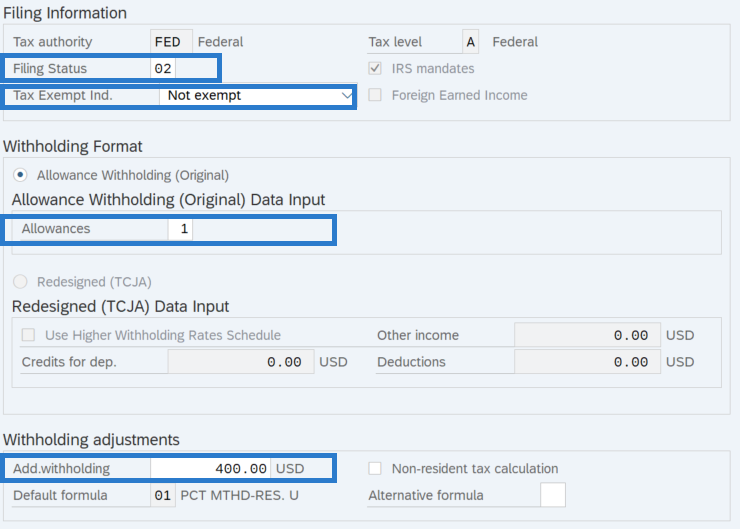 TIPS:
TIPS:The Filing Status, Credits for dep., Tax Exempt Ind., Add.withholding, Other income, and Deductions fields should be completed based on the employee’s Form W-4 – Employee’s Withholding Allowance Certificate selections. All employees hired after January 2020 must use the Redesigned (TCJA) to align with the selection options located on the form. The Allowance Withholding (original) is only used for employees who completed their W4 form prior to January 2020.
Filing Status should contain the box checked in Step 1(c) of the Form W-4:
- Single or Married filing separately:
- 01 or 03
- Married filing jointly (or Qualifying widow(er))
- 04 or 08
- Head of household
- 06
NOTE: Do not use 02 as it is for employees that have an active Form W-4 from 2019 or earlier.
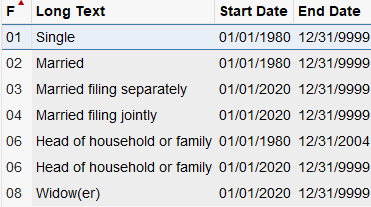
- Single or Married filing separately:
The Use Higher Withholding Rates Schedule indicator should be checked if the employee has checked the box in Step 2 of the Form W-4.
Credits for dep. should reflect the total amount in Step 3 of the Form W-4.
The Tax Exempt Ind. field determines if the employee is exempt from taxation. The field will default to not exempt.
Using the Tax Exemption indicator “Y” will make the wages exempt from taxation and not reportable to the IRS.
Example for this indicator: Payments processed for deceased employees.
Using the Tax Exemption indicator “R” will make the wages exempt from taxation and earnings reportable to the IRS.
Example for this indicator: Employees who submit a W-4 with the filing status of “exempt.” Employees claiming except from withholding will write the word ‘Exempt’ in the space under Step 4(c) of the Form W-4.
Add.withholding should contain the amount in Step 4(c) of the Form W-4.
The Non-resident tax calculation indicator should be selected for an employee designated as a non-resident for payroll tax calculation purposes. See Publication 515, Withholding of Tax on Nonresident Aliens and Foreign Entities.
Other income should contain the amount in Step 4(a) of the Form W-4.
Deductions should contain the amount in Step 4(b) of the Form W-4.
-
Step 17
Click the Enter button to validate the information.
-
Step 18
Click the Save button.
-
Step 19
Complete the Add. Withh. Info. US (0234) infotype.
The following field is mandatory:
- Empl.override group
 TIPS:
TIPS:The Supplemental Method field should be left blank. Do not enter a selection.
Use the Override amount field to enter a federal withholding override. An amount entered in the Override amount box will result in that exact amount of federal withholding for the period or periods the record is active.
Example, if $100 is entered into the override amount box, $100 is the total amount of the federal withholding that will process for the employee. The system will ignore any related entries on the Withholding Info W4/W5 (0210) infotype.
An override is most commonly used when an employee has been paid outside of HRMS and that payment is captured in HRMS using wage types 3101/3111, when an agency has made the choice to adjust the withholding amount to reflect what would have been deducted over 2 payroll periods.
Note: Agencies who choose to override are accepting the risk that the IRS could question the adjustment.
The Override Percentage field should be left blank.There is not a place on the W-4 that would allow for a percentage. Refer to IRS Publication 15, for information on Invalid Forms W-4.
Empl.override group (Employee Override Group) is the Washington Workers' Compensation risk classification that an employee holds for a particular job.
The Employee Override Group must match your agency Business Area. For this example, the employee has been hired into Business Area 1790 – Department of Enterprise Services. If the numbers do not match, it will cause incorrect Medical Aid amounts to be withheld from the employee. Additionally, employer costs will be incorrect.
The Common Paymaster field should be left blank. Do not use this checkbox.
The No Tax field should be left blank. Do not use this checkbox.
-
Step 20
Click the Enter button to validate the information.
-
Step 21
Click the Save button.
Stop:This will mark the end of the Concurrent Employment Action using PA40. The remaining steps in this procedure will direct you to make additional updates if necessary.
-
Step 22
If the employee lives or works in Oregon or Idaho, follow the Additional Steps for Out-of-State Employees user procedures to set up the appropriate taxes.
In addition, please work with the personnel administration processor to ensure an employee has an Out-of-State Work Location (9) address record.
Stop:This will mark the end of the Concurrent Employment Action; benefits (if eligible) are maintained manually. After saving, click the Exit button. Notify the benefits and time and attendance processors of the concurrent appointment and ensure they have the appropriate information to complete any necessary entries.
